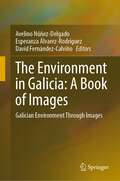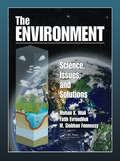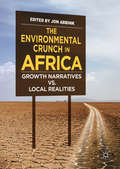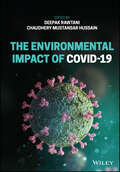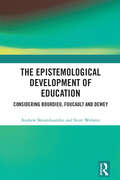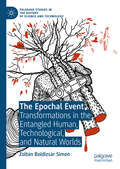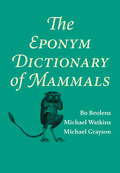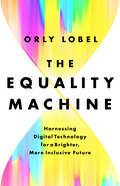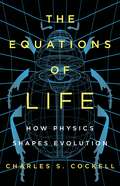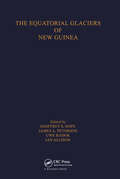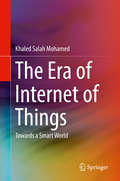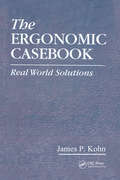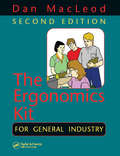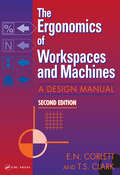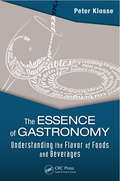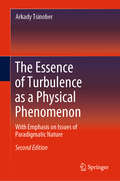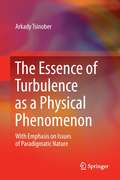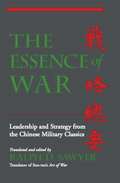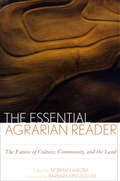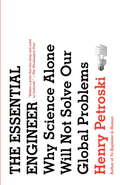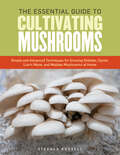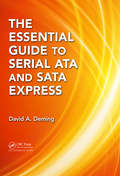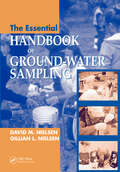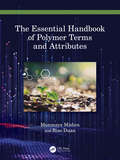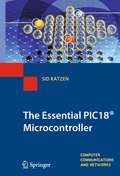- Table View
- List View
The Environment in Galicia: Galician Environment Through Images
by Avelino Núñez-Delgado Esperanza Álvarez-Rodríguez David Fernández-CalviñoThis book describes the environment in Galicia (NW Spain), with researchers and professors presenting their own photographs of relevant aspects. This richly illustrated book explains atmospheric, geologic, water, soils, landscapes, and environmental issues and treatments for a broad audience, including students and the general public, to raise awareness and effectively develop strategies to meet the Sustainable Development Goals.
The Environment: Science, Issues, and Solutions
by Mohan K. Wali M. Siobhan Fennessy Fatih EvrendilekStrongly grounded in the scientific method and evidence, The Environment: Science, Issues, and Solutions presents an organized, accessible, building block approach that introduces the principles of ecology. This book examines the effects of technology use and the unprecedented economic growth and development that has tipped the natural balance of the environment, resulting in serious local, regional, and global environmental problems. This comprehensive text explores the need for interrelated long-term solutions for the prevention and mitigation of environmental problems.
The Environmental Crunch in Africa: Growth Narratives Vs. Local Realities
by Jon AbbinkThis book discusses the problems and challenges of environmental–ecological conditions in Africa, amidst the current craze of economic growth and ‘development’. Africa’s significant economic dynamics and growth trajectories are marked by neglect of the environment, reinforcing ecological crises. Unless environmental–ecological and population growth problems are addressed as an integral part of developmental strategies and growth models, the crises will accelerate and lead to huge costs in later years. Chapters examine multiple emerging tension points all across the continent, including the potential benefits and harm of growing urban-based ecotourism, the trajectory of labour-saving technologies and the problems facing agro-pastoralism. Although environmental management and sustainability features of African rural societies should not be idealized, functional 'traditional' economies, interests and management practices are often bypassed, seen by state elites as inefficient and inhibiting 'growth'. In many regions the seeds are now sown for lasting environmental crises that will affect local societies that have rarely been given opportunity to claim accountability from the state regimes and donors driving these changes.
The Environmental Impact of COVID-19
by Chaudhery Mustansar Hussain Deepak RawtaniTHE ENVIRONMENTAL IMPACT OF COVID-19 Discover the wider environmental effects of the COVID-19 pandemic with this up to date resource from leading voices in the field The Environmental Impact of COVID-19 delivers an insightful analysis of various environmental aspects of the COVID-19 pandemic that have caused global concern. The book discusses the transmission of COVID-19 in the environment, the pandemic’s environmental impact, risk mitigation and management, management of COVID-related waste, and the environmental implications of the virus. It also considers the socio-economic implications of COVID-19’s spread, including the effects of international lockdowns on different strata of society and various industries, including the biomedical industry, the environmental industry, and the pharmaceutical industry. An entire section of the text is devoted to a discussion about the waste generated due to COVID-19 and the effect of that waste on different environmental bodies. Another is dedicated to the impact of COVID-19 on the environment in the short- and long-term, including its effect on climate and climate change. Readers will also benefit from the inclusion of: A thorough introduction to the transmission of COVID-19 in the environment, including its viability in different environmental media and the effect of environmental factors in its transmission An evaluation and analysis of COVID-19, including traditional analytical techniques and sampling for COVID-19 and modern sensor-based techniques for identification An exploration of the socio-economic implications of COVID-19, including its effect on a variety of industries A treatment of the environmental impact of COVID-19 in the context of risk mitigation and management Perfect for academics and industry professionals whose work requires them to understand the wider environmental implications of the SARS-Cov-2 pandemic, The Environmental Impact of COVID-19 will also earn a place in the libraries of private sector professionals working on products and services that aim to reduce the environmental impact of the coronavirus.
The Epistemological Development of Education: Considering Bourdieu, Foucault and Dewey
by Scott Webster Andrew SkourdoumbisThis book documents the political and economic ramifications of the policy impetus for a ‘science of education’ and what this means for classroom teachers, their teaching practices and for the field of education. In a critical exploration of current research and policy articulations of the purposes of education, with attention given to Australia, the UK and the USA, this book delineates the evaluative mechanisms involved in the strategic science as method adoption of accountability, competitiveness and test-driven criteria used in major education policy. It brings together the disciplines of sociology and philosophy by drawing on the theoretical insights of Michel Foucault, Pierre Bourdieu and John Dewey. In addition, the book argues for the deliberate use of the theoretical in education and is against the contemporary unquestioning advocacy that often accompanies a narrowly defined master narrative of a science of education. This book will be of special interest to post-graduate students as source material in general education courses and is also intended for academics with an interest in educational theory/philosophy and the sociology of education.
The Epochal Event: Transformations in the Entangled Human, Technological, and Natural Worlds (Palgrave Studies in the History of Science and Technology)
by Zoltán Boldizsár SimonThis book is a unique attempt to capture the growing societal experience of living in an age unlike anything the world has ever seen. Fueled by the perception of acquiring unprecedented powers through technologies that entangle the human and the natural worlds, human beings have become agents of a new kind of transformative event. The ongoing sixth mass extinction of species, the prospect of a technological singularity, and the potential crossing of planetary boundaries are expected to trigger transformations on a planetary scale that we deem catastrophic and try to avoid. In making sense of these prospects, Simon’s book sketches the rise of a new epochal thinking, introduces the epochal event as an emerging category of a renewed historical thought, and makes the case for the necessity of bringing together the work of the human and the natural sciences in developing knowledge of a more-than-human world.
The Eponym Dictionary of Mammals
by Michael Watkins Bo Beolens Michael GraysonLearn the origins of over 2,000 mammal species names with this informative reference guide.Just who was the Przewalski after whom Przewalski's horse was named? Or Husson, the eponym for the rat Hydromys hussoni? Or the Geoffroy whose name is forever linked to Geoffroy's cat? This unique reference provides a brief look at the real lives behind the scientific and vernacular mammal names one encounters in field guides, textbooks, journal articles, and other scholarly works.Arranged to mirror standard dictionaries, the more than 1,300 entries included here explain the origins of over 2,000 mammal species names. Each bio-sketch lists the scientific and common-language names of all species named after the person, outlines the individual’s major contributions to mammalogy and other branches of zoology, and includes brief information about his or her mammalian namesake’s distribution. The two appendixes list scientific and common names for ease of reference, and, where appropriate, individual entries include mammals commonly—but mistakenly—believed to be named after people.The Eponym Dictionary of Mammals is a highly readable and informative guide to the people whose names are immortalized in mammal nomenclature.“A small treasure trove of information about the people whose names are immortalized in mammalian nomenclature. Given that we mammalogists are prone to ancestor worship, I expect it to be a best-seller.” —Don E. Wilson, Journal of Mammalian Evolution“This is a great reference for the mammalogy professional or student, or the curious naturalist.” —Wildlife Activist“This is a splendid book which fills a real gap in zoological literature.” —Nicholas Gould, International Zoo News
The Equality Machine: Harnessing Digital Technology for a Brighter, More Inclusive Future
by Orly LobelAN ECONOMIST BEST BOOK OF 2022 At a time when AI and digital platforms are under fire, Orly Lobel, a renowned tech policy scholar, defends technology as a powerful tool we can harness to achieve equality and a better future. Much has been written about the challenges tech presents to equality and democracy. But we can either criticize big data and automation or steer it to do better. Lobel makes a compelling argument that while we cannot stop technological development, we can direct its course according to our most fundamental values. With provocative insights in every chapter, Lobel masterfully shows that digital technology frequently has a comparative advantage over humans in detecting discrimination, correcting historical exclusions, subverting long-standing stereotypes, and addressing the world&’s thorniest problems: climate, poverty, injustice, literacy, accessibility, speech, health, and safety. Lobel's vivid examples—from labor markets to dating markets—provide powerful evidence for how we can harness technology for good. The book&’s incisive analysis and elegant storytelling will change the debate about technology and restore human agency over our values.
The Equations of Life: How Physics Shapes Evolution
by Charles S. CockellA groundbreaking argument for why alien life will evolve to be much like life here on EarthWe are all familiar with the popular idea of strange alien life wildly different from life on earth inhabiting other planets. Maybe it's made of silicon! Maybe it has wheels! Or maybe it doesn't. In The Equations of Life, biologist Charles S. Cockell makes the forceful argument that the laws of physics narrowly constrain how life can evolve, making evolution's outcomes predictable. If we were to find on a distant planet something very much like a lady bug eating something like an aphid, we shouldn't be surprised. The forms of life are guided by a limited set of rules, and as a result, there is a narrow set of solutions to the challenges of existence.A remarkable scientific contribution breathing new life into Darwin's theory of evolution, The Equations of Life makes a radical argument about what life can--and can't--be.
The Equatorial Glaciers of New Guinea
by James A. Peterson Uwe Radok Geoffrey S. Hope Ian AllisonThe Equatorial Glaciers of New Guinea includes the Results of the 1971-1973 Australian Universities' Expeditions to Irian Jaya: Survey, Glaciology, Meteorology, Biology and Paleoenvironments.
The Era of Internet of Things: Towards a Smart World
by Khaled Salah MohamedThis book introduces readers to all the necessary components and knowledge to start being a vital part of the IoT revolution. The author discusses how to create smart-IoT solutions to help solve a variety of real problems. Coverage includes the most important aspects of IoT architecture, the various applications of IoT, and the enabling technologies for IoT. This book presents key IoT concepts and abstractions, while showcasing real case studies. The discussion also includes an analysis of IoT strengths, weaknesses, opportunities and threats. Readers will benefit from the in-depth introduction to internet of things concepts, along with discussion of IoT algorithms and architectures tradeoffs. Case studies include smart homes, smart agriculture, and smart automotive.
The Ergonomic Casebook: Real World Solutions
by James P. KohnOne of the greatest challenges in the occupational health and safety profession is the application of theory to actual workplace practice. The difference between how the workplace should be ideally designed and the limitations that occur in pre-existing facilities are often difficult to overcome. With examples from the service industry, heavy industry, agriculture, and the office, this text bridges these gaps between theory and practice by using case studies to illustrate sound ergonomic practices.The Ergonomic Casebook is a resource that professionals and students can use as a guide for solutions to real-world ergonomic problems. Working examples from ergonomic programs in a variety of industries are included. Case studies describe methods for identifying ergonomic problems, and specific causes are reported. Recommended strategies for the elimination of identified stressors are indicated. Implemented strategies and evaluated results are discussed and explained. Applications of this book are endless. Whether you are a health and safety professional with limited expertise in ergonomics or a student taking a health and safety course, you will gain extensive insight into ergonomic problem solving as a result of the case studies presented in The Ergonomic Casebook.
The Ergonomics Kit for General Industry
by Dan MacLeodWritten by Dan MacLeod, one of the most experienced practitioners in the field, The Ergonomics Kit for General Industry, Second Edition contains everything you need to set up or improve your workplace ergonomics process. MacLeod describes the financial benefits of workplace ergonomics and ways to think about these tools that make good business sens
The Ergonomics Of Workspaces And Machines: A Design Manual
by E. N. Corlett T. S. ClarkThis influential text was fully revised and updated for the second edition with the addition of substantial new material, and takes the reader, in a logical sequence, through the main areas of ergonomics relevant to design, in a way that allows ergonomics to be integrated with all aspects of the design process.
The Essence of Gastronomy: Understanding the Flavor of Foods and Beverages
by Peter KlosseThe Essence of Gastronomy: Understanding the Flavor of Foods and Beverages presents a new comprehensive and unifying theory on flavor, which answers ancient questions and offers new opportunities for solving food-related issues. It presents gastronomy as a holistic concept, focusing not only on the food and its composition but also on the human who
The Essence of Turbulence as a Physical Phenomenon: With Emphasis On Issues Of Paradigmatic Nature
by Arkady TsinoberNow in its second edition, this book clearly, concisely and comprehensively outlines the essence of turbulence. In view of the absence of a theory based on first principles and adequate tools to handle the problem, the “essence” of turbulence, i.e. what turbulence really is from a fundamental point of view, is understood empirically through observations from nature, laboratories and direct numerical simulations rather than explained by means of conventional formalistic aspects, models, etc., resulting in pertinent issues being described at a highly theoretical level in spite of the mentioned lack of theory.As such, the book highlights and critically reexamines fundamental issues, especially those of paradigmatic nature, related to conceptual and problematic aspects, key misconceptions and unresolved matters, and discusses why the problem is so difficult. As in the previous edition, the focus on fundamental issues is also a consequence of the view that without corresponding advances in fundamental aspects there is little chance of progress in any applications. More generally there is a desperate need for physical fundamentals of a great variety of processes in nature and technology in which turbulence plays a central role. Turbulence is omnipresent throughout the natural sciences and technology, but despite the vast sea of information available the book retains its brevity without oversimplifications, making it of interest to a broad audience.
The Essence of Turbulence as a Physical Phenomenon: With Emphasis on Issues of Paradigmatic Nature
by Arkady TsinoberThis book critically reexamines what turbulence really is, from a fundamental point of view and based on observations from nature, laboratories, and direct numerical simulations. It includes critical assessments and a comparative analysis of the key developments, their evolution and failures, along with key misconceptions and outdated paradigms. The main emphasis is on conceptual and problematic aspects, physical phenomena, observations, misconceptions and unresolved issues rather than on conventional formalistic aspects, models, etc. Apart from the obvious fundamental importance of turbulent flows, this emphasis stems from the basic premise that without corresponding progress in fundamental aspects there is little chance for progress in applications such as drag reduction, mixing, control and modeling of turbulence. More generally, there is also a desperate need to grasp the physical fundamentals of the technological processes in which turbulence plays a central role.
The Essence of War: Leadership and Strategy from the Chinese Military Classics
by Ralph D. SawyerFrom antiquity, the history of China has been marked by invading tribes, warring states, and popular uprisings. This heritage of conflict produced a body of martial literature exploring the fundamental principles of warfare and their methods of employment. Fully aware of the tragic consequences of battle, the authors of these texts emphasized that bloodshed and war should be avoided whenever possible. But, they argued, this is possible only when the principles of leadership and strategy have been mastered and the dynamics of conflict thoroughly analyzed. Over the centuries, these texts have been studied throughout Asia, not only by generals on the battlefield but by leaders of all kinds concerned with the management of human conflict in all its forms. The Essence of War presents eight of these classics (written from 500 B. C. E. to 700 C. E. ), including Sun-tzu's Art of War and Sun Pin's Military Methods. The book introduces the core principles of Chinese military science, grouping selected passages and key quotations into five thematic sections encompassing forty-one topical chapters: Fundamentals, Tao of Warfare, Tao of Command, Tactical Essentials, and Tactical Specifics. Translator Ralph D. Sawyer provides here a concise introduction to Chinese military thought and influential materials not only of traditional import, but also for contemporary study and enduring value in both business and military circles throughout the world.
The Essential Agrarian Reader: The Future of Culture, Community, and the Land
by Norman Wirzba“Eminently quotable and passionately argued essays” on living in harmony with the earth and each other, by Wes Jackson, Wendell Berry, and more (Library Journal, starred review).Includes a Foreword by Barbara KingsolverA compelling worldview with advocates from around the globe, agrarianism challenges the shortcomings of our industrial and technological economy. Not simply focused on farming, the agrarian outlook encourages us to develop practices and policies that promote the health of land, community, and culture. Agrarianism reminds us that no matter how urban we become, our survival will always be inextricably linked to the precious resources of soil, water, and air.Combining fresh insights from the disciplines of education, law, history, urban and regional planning, economics, philosophy, religion, ecology, politics, and agriculture, these original essays develop a sophisticated critique of our culture’s current relationship to the land, while offering practical alternatives. Leading agrarians, including Wendell Berry, Vandana Shiva, Wes Jackson, Gene Logsdon, Brian Donahue, Eric Freyfogle, and David Orr, explain how our goals should be redirected toward genuinely sustainable communities. These writers call us to an honest accounting and correction of our often-destructive ways. They suggest how our society can take practical steps toward integrating soils, watersheds, forests, wildlife, urban areas, and human populations into one great system—a responsible flourishing of our world and culture.
The Essential Engineer: Why Science Alone Will Not Solve Our Global Problems
by Henry PetroskiFrom the acclaimed author of The Pencil and To Engineer Is Human, The Essential Engineer is an eye-opening exploration of the ways in which science and engineering must work together to address our world&’s most pressing issues, from dealing with climate change and the prevention of natural disasters to the development of efficient automobiles and the search for renewable energy sources. While the scientist may identify problems, it falls to the engineer to solve them. It is the inherent practicality of engineering, which takes into account structural, economic, environmental, and other factors that science often does not consider, that makes engineering vital to answering our most urgent concerns.Henry Petroski takes us inside the research, development, and debates surrounding the most critical challenges of our time, exploring the feasibility of biofuels, the progress of battery-operated cars, and the question of nuclear power. He gives us an in-depth investigation of the various options for renewable energy—among them solar, wind, tidal, and ethanol—explaining the benefits and risks of each. Will windmills soon populate our landscape the way they did in previous centuries? Will synthetic trees, said to be more efficient at absorbing harmful carbon dioxide than real trees, soon dot our prairies? Will we construct a &“sunshade&” in outer space to protect ourselves from dangerous rays? In many cases, the technology already exists. What&’s needed is not so much invention as engineering.Just as the great achievements of centuries past—the steamship, the airplane, the moon landing—once seemed beyond reach, the solutions to the twenty-first century&’s problems await only a similar coordination of science and engineering. Eloquently reasoned and written, The Essential Engineer identifies and illuminates these problems—and, above all, sets out a course for putting ideas into action.
The Essential Guide to Cultivating Mushrooms: Simple and Advanced Techniques for Growing Shiitake, Oyster, Lion's Mane, and Maitake Mushrooms at Home
by Stephen RussellFrom the basics of using mushroom kits to working with grain spawn, liquid cultures, and fruiting chambers, Stephen Russell covers everything you need to know to produce mouthwatering shiitakes, oysters, lion’s manes, maitakes, and portobellos. Whether you’re interested in growing them for your own kitchen or to sell at a local market, you’ll soon be harvesting a delicious and abundant crop of mushrooms.
The Essential Guide to Serial ATA and SATA Express
by David A. DemingUsed in laptop and desktop computers, low-end servers, and mobile devices, Serial ATA (Advance Technology Attachment), or SATA, is the pervasive disk storage technology in use today. SATA has also penetrated the enterprise computing environment by adding hardware components for fail-over, extending command processing capabilities, and increasing de
The Essential Handbook of Ground-Water Sampling
by David M. Nielsen Gillian NielsenTremendous improvements in ground-water sampling methodologies and analytical technologies have made it possible to collect and analyze truly representative samples to detect increasingly lower levels of contaminants-now in the sub-parts-per-billion range. Though these new methods produce more accurate and precise data and are less expensive, many
The Essential Handbook of Polymer Terms and Attributes
by Biao Duan Munmaya K MishraThe Essential Handbook of Polymer Terms and Attributes not only acts as an encyclopaedia of polymer science but also fosters an appreciation for the significance of polymers in fields including materials science, chemistry, engineering, and medicine. This book serves as an excellent reference book, covering every possible term and attribution associated with the vast and diverse field of polymers. This comprehensive volume serves as a vital resource for researchers working in industry and academia, offering a clear and concise exploration of polymer science with the most essential reference data available. Each polymer term is defined in a straightforward manner, ensuring that readers of all levels can grasp the concepts. The book goes beyond mere definitions, providing context and insights into the applications, properties, and synthesis. Bringing polymer terms and attributes together in one place, the book provides a broad knowledge of polymer science and facilitates idea generation for researchers and students embarking on projects related to a specific field of polymer science. Key features: This book covers all possible terms associated with the field of “polymers" and related areas, granting readers a comprehensive understanding of the entire spectrum of polymers. The organization of the book follows an alphabetical format, enabling quick and convenient access to specific terms. Each polymer term is clearly defined with a figure or scheme as needed, allowing readers to visualize the structures, processes, and applications involved. This book is written for science students, chemists, polymer scientists, chemical engineers, pharmaceutical scientists, biomedical scientists, biotechnologists, product formulators, materials scientists, and scientists working on polymers.
The Essential PIC18® Microcontroller
by Sid KatzenMicroprocessors are the key component of the infrastructure of our 21st-century electronic- and digital information-based society. More than four billion are sold each year for use in 'intelligent' electronic devices; ranging from smart egg-timer through to aircraft management systems. Most of these processor devices appear in the form of highly-integrated microcontrollers, which comprize a core microprocessor together with memory and analog/digital peripheral ports. By using simple cores, these single-chip computers are the cost- and size-effective means of adding the brains to previous dumb widgets; such as the credit card. Using the same winning format as the successful Springer guide, The Quintessential PIC® Microcontroller, this down-to-earth new textbook/guide has been completely rewritten based on the more powerful PIC18 enhanced-range Microchip MCU family. Throughout the book, commercial hardware and software products are used to illustrate the material, as readers are provided real-world in-depth guidance on the design, construction and programming of small, embedded microcontroller-based systems. Suitable for stand-alone usage, the text does not require a prerequisite deep understanding of digital systems. Topics and features: uses an in-depth bottom-up approach to the topic of microcontroller design using the Microchip enhanced-range PIC18® microcontroller family as the exemplar; includes fully worked examples and self-assessment questions, with additional support material available on an associated website; provides a standalone module on foundation topics in digital, logic and computer architecture for microcontroller engineering; discusses the hardware aspects of interfacing and interrupt handling, with an emphasis on the integration of hardware and software; covers parallel and serial input/output, timing, analog, and EEPROM data-handling techniques; presents a practical build-and-program case study, as well as illustrating simple testing strategies. This useful text/reference book will be of great value to industrial engineers, hobbyists and people in academia. Students of Electronic Engineering and Computer Science, at both undergraduate and postgraduate level, will also find this an ideal textbook, with many helpful learning tools. Dr. Sid Katzen is Associate to the School of Engineering, University of Ulster at Jordanstown, Northern Ireland.
